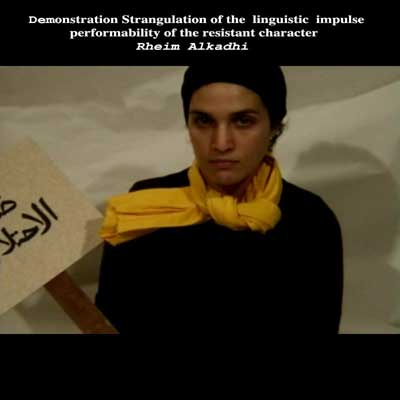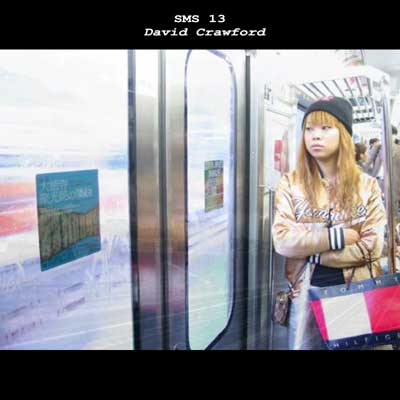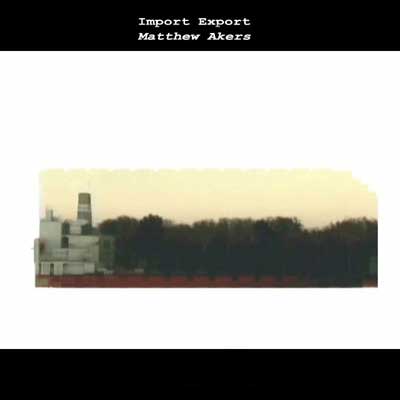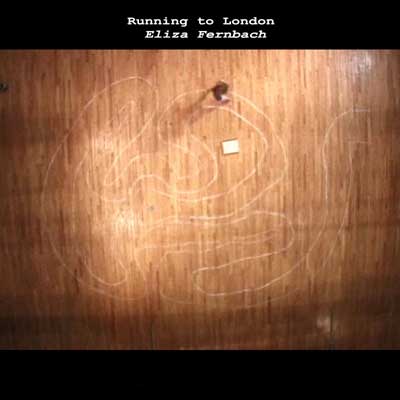Review
of t(here) video works exhibition
Nancy
Macgregor
Accompanying the launch of its third issue, "Lost In Translation", online journal Drain hosted a reception featuring t(here), an exhibition of video works by thirteen international artists.[1] Curated by Avantika Bawa (who also contributed work), t(here) explored binaries, hybrids and the soft, shifting and sometimes invisible spaces in between "there" and "here". Projected onto one wall of Savannah's 'Current Space' (which, as both apartment and gallery space, is itself a hybrid) the work used such varied terrain as adolescence, cultural identity, language and the medium of video itself to explore the notion of binaries and searchingly interrogate the sometimes uncertain middle ground. Also included in the event was Kingdom Come and/or Punch Holes in the Body Politic, a performance piece viewed via web-cast by Australian artist Mike Parr organized by Adrian Parr and Celina Jeffery.
In one of the strongest works, Demonstration: Strangulation of the Linguistic Impulse/performability of the resistant character, Rheim Alkadhi uses written language to examine cultural imperialism. Arabic characters translating to "No thank you, I've had enough"[2] were embroidered onto a plucked, dead chicken which is strangled by floppy 'Golden Arches', the brand symbol of fast food giant McDonalds. The symbol not only represents the one corporation, but has become (as the artist employs it) a ubiquitous symbol for the very idea of globalization. Inspired by an incident in which an Iraqi McDonalds employee was fired for speaking her native language[3], Alkadhi comments on the Americanization that takes place not just within this one company, but in many multi-national corporations—voices of difference, like that of the McDonalds worker and like that of the chicken are silenced by corporate America. The chicken is eventually rescued by a feminine hand bearing a pair of large shears that, after several attempts (timed to the ticking and buzzing of an egg timer), finally cuts away the arch noose and frees the strangled poultry. The performer then reappears bearing a sign with un-translated characters. Always interested in cultural identity, Alkadhi (the daughter of an Iraqi and an American), deftly, and with some humor, explores and presents for the viewer the complications inherent in retaining one's cultural identity while trying to participate in an increasingly American, English-speaking economy.

In James Gladman's fascinating sort of science project, Faces, the artist diagramed changing facial expressions in order to expose and quantify "micro-expressions"—our revealing in-between faces.[4] Gladman drastically slowed, repeated and pieced together several television clips all featuring tight views of individual's faces. As the moods of soap opera actors and litigators on the "People's Court" change (or, perhaps more accurately, morph), Gladman's notations and scales identify and quantify the presence (and amount) of different emotions indicated by the changing facial expressions revealing frame by frame the infinitesimal moment when surprise turns into disbelief or when happiness turns into fear; slowing this shifting from one expression to another reveals emotions that would otherwise remain invisible or undetected. In one particularly striking clip a "People's Court" defendant who, as he spikes Gladman's anger scale, is caught mid-expression with such a look of vile contempt, the viewer fears for Judge Wapner's safety—a flash of emotion easily missed when viewed in real-time.

In Stop Motion Studies, David Crawford also identifies commonality within a large group, but his project is a bit grander scope creating a unified, cross-cultural portrait of international subway riders. Applying the principles of stop-motion photography to digital recording processes, Crawford filmed subway riders in cities all over the world including Tokyo, New York, London and Goteburg, Sweden, each view recorded as countless stills within the span of approximately a minute. Crawford then assembled these individual vignettes, creating a unified character in a diverse pool of people, narrowing cultural distances–footage of Japan blends into Austria which looks just like New York. If not for the occasional written signs that flash into view, the locations of the trains would be indistinguishable, the riders could be anywhere, their sleepy, distracted faces displaying an international curiosity in (and wariness of) the camera blinking at them. The work is available on the internet (www.stopmotionstudies.net) where the viewer can access the individual studies, clicking on them one at a time. But while the internet footage is still visually beautiful in its hyper-clear colors and interesting in its halting progression as the sequences unfold, the projection of the assembled studies provides an intimacy and immediacy greater than in its original web form as well as more cohesively presenting the artist's Big Idea—that across borders there are shared experiences and common values.

Matthew Akers' Import-Export mixes images of container ships steaming in and out of a busy port with vertical bars (thirteen representing the stripes of the American flag). Perhaps one of the more interesting things about this particular piece is that though like the other pieces it deals with a, location becomes a very important part of the work when thought about in conjunction with the space in which it was exhibited. Had the attendees looked out the back windows of the building onto the Savannah River, they would have witnessed the real-life scene recorded by Akers. Though like most of the work, the ships coming and going evoked the work's relationship to the space (that fact that both were taking place in the same place) served to reinforce the idea of place and location.

In a different take on motion and travel, Eliza Fernbach's simple and compelling video Running to London explores neither starting point no end point, but what lies in between. Shot primarily from above, a small pig-tailed girl, then a woman, then an old man meander their way through and over a loopy, chalk-outline maze. In this piece Fernbach demonstrates her interest in how we, in the 21st century, spend our time. Rather than rocketing toward our destinations Fernbach, it seems, would rather us expand time and examine the journey itself as the figures never complete the maze start to finish but rather walk across it, stop, examine objects placed in the maze (a chair, shoes), and back-track their own paths. This work, it seems, is not about linear progress, but exploration of motion, time and purpose.

Swati Khurana's "there" and "here" is childhood and adulthood, individuality and wife-ness. Reflecting on her own Hindu wedding, she re-casts herself as a bride in her work Ode to Persephone and Snow Days one of two pieces the artist contributed to the exhibition. In a perhaps too complicated mix of Hindu, Western and personal symbolism, Khurana sees the image of the bride "as operating as a stand-in for princess, abductees, corpse, virgin, trickster—femininity itself"[5] and uses it to explore the struggle between identity and commodity in the "negotiation and exchange"[6] that surrounds marriage. But much more interesting is the artist's interest in readiness to marry and in adolescence because for the artist, marriage also exposes the vulnerable space between childhood and adulthood. Her Persephone, marrying the snow in which she lays, is still very much caught in between youth and the maturity required for such a rite. Dressed in a little girl's fantasy of colorful Indian fabric, jewelry and a mass of flowers in her hair, she wonders not about love, but whether (in typically American adolescent language) whether she "like-likes" him. "That is not blood between her legs", the caption narrative states, "it is pomegranate juice" further embedding her bride in the neither-here-nor-there of adolescence.
Through all of this, the din of the reception, the comings and goings of the audience, the pulsing of the videos, Mike Parr lay exhausted and prostrate on a gallery floor in Sydney, Australia. Viewed via web-cast in the Savannah space, Kingdom Come and/or Punch Holes in the Body Politic was a performance piece in three parts that took place in the gallery Art Space in Sydney and viewed via web-cast in Savannah. The piece began with Parr sitting in a chair in the empty gallery in a bright orange suit, one shoe removed. To his bare foot was attached a node connected to a wire through which electric shocks were sent directly to the artist's body, administered by gallery visitors only a few feet away as an exploration of torture and the hostility and aggression of the audience. The painful shocks continued for six hours until Parr was finally disconnected and rested. It is the aftermath of the shocks that confronted visitors to the Savannah exhibition—the image of Parr's prone, orange body that stayed almost perfectly still for hours, both a product of mechanized cruelty as well as a formal study of color and composition. "...Propped up... Exhaustion... No dialogue or dialectic..." wrote Parr of the performance. "...Urination on the floor... the constant piercing oscillation of noise that accompanies image holes punched through the body...Schizophrenic..."[7] Quietly existing somewhere between consciousness and unconsciousness, slowly Parr's image was overlaid with text bringing the piece to conclusion.
What is remarkable about all the included work is its commitment to the difficult space between 'there' and 'here'. In-between is not a very comfortable place and with few exceptions, every artist included in the exhibition sensitively explored this difficult theme. If Drain's third issue is interested in loss that occurs in translation, the work included in t(here) is interested in recovery. By closely examining the spaces in between the binaries and hybrids, what is contained therein is preserved—not lost in translation at all.
[1] t(here) also included work by curator Avanitka Bawa, Matthew Akers, Prema Murthy, Lane Last, Mono Vatamanu and Florin Tudor, Kevin Jones, Sandro Imperato, Victor Ruano, Tim Jackson with Galen Scorer, Edward Tang, Jon Lynn, Pablo Tauler and a collective work by Matt Jenkins, Adriana Nieto, Miguel Angel Tarango and Ximena Quintana.
2 Alkadhi, Rheim, Artist Statement, 2005
3 Alkadhi, Rheim, www.birwaz.org/alkadhi,2005
4 Gladman, James, www.jgladman.com/artwork/faces, 2005
5 Khurana, Swati, Artist Statement, 2005
6 Khurana, Swati, www.ourmedia.org/node/37859, 2005
7 Parr, Mike, www.artspace.org.au/2005/04/parr
Sources
Alkadhi, Rheim. Artist Statement, 2005.
Alkadhi, www.birwaz.org/alkadhi, 2005.
Bawa, Avantika. t(here) Curatorial Statement, 2005.
Gladman, James. www.jgladman.com, 2005.
Khurana, Swati, Artist Statement, 2005.
Khuarana, www.ourmedia.org/node/37859, 2005.
Parr, Mike. www.artspace.org.au/2005/04/parr, 2005.